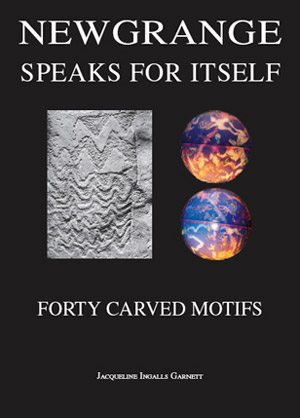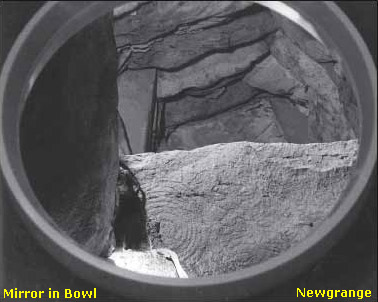Newgrange Speaks for Itself
 Newgrange Speaks for Itself: Forty Carved Motifs & Related Site Features by Jacqueline Ingalls Garnett.
Newgrange Speaks for Itself: Forty Carved Motifs & Related Site Features by Jacqueline Ingalls Garnett.
Firmly grounded in Newgrange's structure and engravings, this book offers some revolutionary insights into its religion and its science. Forty motifs are explained as emblems of features meant to ensure life beyond the grave, including the nine "rungs" in the passage, the "leak" in the chamber, the stone bowl and marbles, and sightlines through the vault.
The author argues that some of Michael O'Kelly's discoveries may suggest that Newgrange was retooled when precession removed the targets of those sightlines. The rich cluster of afterlife agencies revealed by Newgrange's features and emblems, unique as a fingerprint, can be recognized in myths, fairytales, and superstitions which may shed light on this previously almost completely unknown stone-age faith.
Jacqueline Garnett received her formal education in literature, sciences, and languages at the University of Washington, where she began her extended study of Newgrange.
Purchase at Amazon.com or Amazon.co.uk
Excerpt from Chapter 3
Newgrange Speaks for Itself: Forty Carved Motifs & Related Site Features by Jacqueline Ingalls Garnett, an excerpt from Chapter 3 - An Immemorial WellTime and lime again, from the rediscovery of the chamber in 1699 up until O'Kelly's installation of a protective concrete umbrella over the vault, water had been found to be dripping or trickling into the monumental slab and bowl in the right hand recess.
Precipitated water percolated through the porous mound in great abundance. Claire O'Kelly explains that conservation efforts had to be undertaken "...so as to stop a number of leaks in the chamber, principally one over the basin stone in the east recess." (Illustrated Guide to Newgrange p. 84) Michael O'Kelly remarks that "In winter, water dripped through and frequently the basin stones in the east recess filled up, a circumstance obviously of long standing since in AD 1700 Lhwyd in one of his letters commented: 'We observed that water dropped into the right-hand Bason, tho' it had rained but little in many days..." (Newgrange page 113). The flow was so great that it probably contributed to the development of the serious crack that crosses the massive recess roof stone.
When the slab and bowl filled with water, and if the capstone was tilted up away from the vault, then on a clear night a person at the back of the recess could see a small wedge of starry sky through the chamber aperture, reflected in the surface of the water in the bowl in front of him. Except during the periods when they were blotted out by daylight, he could see the constellation Cassiopeia within the arch of the Milky Way as it wheeled above the monument.
Michael O'Kelly verified the fact that the builders were much occupied by problems of managing water. Passage stones were grooved to direct run-off away from the passage. The grooves were effective, for the passage remained dry. Caulking made of sea sand and burnt soil was found in abundance in corbels at the sensitive point where the passage and chamber roofs joined. Two samples of this material were used for radiocarbon dating. The chamber vault was not excavated, and although the archaeologists replaced small stones that bad been used to fill the spaces between chamber corbels, O'Kelly did not report that any caulking was found there. Had caulking been found it would surely have augmented the very scarce material that was dated.
 O'Kelly's
statement must be read very carefully, bearing in mind the details of his work and reports.
"We have seen that every effort was made by the builders to keep the inside dry – the
outward slope of the chamber and passage roof-corbels, the caulking of the
roof-joints with putty-like burnt soil and sea sand and the cutting of water-grooves on roof-slabs and passage corbels."
O'Kelly's
statement must be read very carefully, bearing in mind the details of his work and reports.
"We have seen that every effort was made by the builders to keep the inside dry – the
outward slope of the chamber and passage roof-corbels, the caulking of the
roof-joints with putty-like burnt soil and sea sand and the cutting of water-grooves on roof-slabs and passage corbels."
Neither grooves nor caulking is reported within the chamber vault. The part of O'Kelly's statement that refers to caulking can apply only to the caulking of the Joints where passage and chamber met, and the part on the water grooves can apply only to the passage.
Almost all of the vault corbels do slant outward, shedding water out into the body of the cairn. But O'Kelly's sectional drawing shows that there is one corbel, and one corbel only, whose inside surface has been drawn as if it were slanted slightly inward, as far as was ascertained. This corbel Is located at the back of the right hand recess. Since cairn pressure would have tended to weigh down the outer ends of the corbel it seems likely that it may originally have had a steeper slope toward the interior of the chamber.
Considering the general purposefulness of the building, it is probable that just as the builders did not intend that water should enter the passage, and the passage stayed dry, they did intend that water should enter the slab and bowl, and water consistently filled these enormous receptacles.
We ourselves waterproof our buildings, but pipe water into various tubs and bowls. The slab in the right recess did not need to be hollowed simply in order to hold the stone bowl, and both slab and bowl seem too massive to have been meant to hold anything but water. Water was certainly not intended to enter where it was found to enter in 1699 and afterwards. The gradual sinking of the whole vault, estimated at about a yard, had short-circuited whatever channel would originally have been devised.
The hypothesis that the bowl was filled by a source inside the chamber recess itself has perhaps some support in the odd fact that absolutely no ceramic was found in the building. The archaeologists did find that there was a small, winter-flowing stream under the passage orthostat R 8.
This spring was not far from an original gap in the passage wall that had been closed by a wall built of small stones. Thus the builders might have obtained water from a source within the monument. A piece of a small stone bowl was found outside the entrance, but it was certainly too small to be practical for filling the large bowl, to say nothing of the slab. The builders probably intended to provide the bowl and slab with their own source of water, and in any event, water went on faithfully filling them for over five thousand years.
The boulder cap sheds an interesting sidelight on the builders' interest to providing water in the chamber. The cap is very expertly finished with selected stones. This was not necessary for stability, although there is a possibility that it was once uncovered, forming a decorative upper segment of the facade. But there is a device called an aerial well which makes use of the fact that dew and fog will condense on a stone-built pile or cairn and may be collected and led down for use.
One famous example was located above Theodosia on the Black Sea. Thirteen forty-foot cairns of loose rock delivered over 500 gallons of pure drinking water a day to the city by pipeline. This type of apparatus has attracted the interest of UNESCO to help supply water in dry regions.
Passage graves were frequently remodeled. Site K west of Newgrange seems to have been remodeled twice. If in some former phase the boulder cap that was wrapped around the hollow chamber of Newgrange had been exposed, it would not only have created a pleasing facade, it would also have had a tendency to work as an aerial well.
The builders could hardly have planned better to insure the collection not only of rain and snow but also of dew. This is significant because from time immemorial, dew has been thought to have supernatural properties, if these properties had some role in the Boyne funeral practice the cap would have provided a modicum of dew along with other atmospheric moisture.
The subject brings to mind a curious detail reported in an early and ruinously clumsy excavation of the nearby passage grave of Dowth: "In the Centre of the Mound a curious funnel or Air shaft was discovered, about 5 inches in Diameter neatly built with small flat Stones. This was reached about 17 feet from the datum line and reached to the base of the Tumulus. It did not appear to have any connection with any Chamber or building which could afford any information as to the probable use for which it was designed."
This funnel certainly conveyed not only air but a token amount of water into the body of the mound. Again, the presence of dew which condensed on the stone lining of the little shaft and ran down the sides may have been a factor that was regarded as hallowing the fabric of the mound.
Purchase at Amazon.com or Amazon.co.uk
Boyne Valley Private Day Tour
 Immerse yourself in the rich heritage and culture of the Boyne Valley with our full-day private tours.
Visit Newgrange World Heritage site, explore the Hill of Slane, where Saint Patrick famously lit the Paschal fire.
Discover the Hill of Tara, the ancient seat of power for the High Kings of Ireland.
Book Now
Immerse yourself in the rich heritage and culture of the Boyne Valley with our full-day private tours.
Visit Newgrange World Heritage site, explore the Hill of Slane, where Saint Patrick famously lit the Paschal fire.
Discover the Hill of Tara, the ancient seat of power for the High Kings of Ireland.
Book Now
Home
| Visitor Centre
| Tours
| Winter Solstice
| Solstice Lottery
| Images
| Local Area
| News
| Knowth
| Dowth
| Articles
| Art
| Books
| Directions
| Accommodation
| Contact
